In the outdoors, I’m not afraid of snakes or bears and definitely not insects. But I’ll admit it: ticks absolutely freak me out. Because ticks can transmit so many diseases, I started carrying a tick removal tool with me at all times.
Yes, the type of tick removal tool you use actually does matter when it comes to safely removing a tick. Here’s what you need to know about tick removal tools and some of the best options for humans.
Quick Recommendation:
Get the to put on your keychain so you’ll always have a tick removal tool with you. But also get the Majestic Pointed-Tip Tweezers or TickEase Tool to put in your first aid kit. These tools aren’t great for everyday carry but do a better job of removing nymph ticks as well as adult ticks. Plus, they are good for splinters too.
Why You Need to Remove Ticks ASAP
In addition to Lyme disease, ticks can transmit many other diseases. The CDC website currently lists 16 different tick-borne illnesses. Scary, right?
The good news is that ticks usually don’t start to feed right away. It usually takes 12-24 hours for the tick to start feeding on you. So, if you are able to remove the tick within 24 hours, there is very little chance of contracting Lyme disease or one of the other tick-borne illnesses.
But You Must Remove the Tick Properly!
To prevent disease, it’s really important that you remove the tick properly. Anything that squeezes or irritates the tick can cause the tick to regurgitate it’s stomach contents into your skin, thus increasing the likelihood that it will transmit disease. This is actually how I got Lyme disease. I accidentally squeezed the body of a nymph tick while removing it (they are tiny!). It was only attached for an hour or so, but squeezing it was enough to get the Lyme bacteria into my body.
The takeaway? Always have a tick removal tool handy so you can properly get any ticks off immediately.
How to Remove a Tick
The CDC says that the best way to remove a tick is to:
- Grab it using fine-tipped tweezers. Flat-tipped tweezers don’t work well for tick removal.
- Grasp as close to the head as possible.
- Pull straight upwards. Do not twist or jerk the tick.
- After removing the tick, clean the bite area and your hands with alcohol, iodine, or soap and water.
- Dispose of the live tick by soaking it in alcohol or sealing it in a bag and throwing it away. Never crush a live tick with your fingers. This could release pathogens.
Do NOT:
The methods below can irritate the tick and increase the chances of pathogens entering your body. Never try to remove a tick by:
- Touch the tick with hot match/fire
- Use peppermint oil or any other essential oils
- Apply petroleum jelly
- Submerse the tick in alcohol
- Try to suffocate the tick
- Squeeze the tick’s body
- Twist the tick
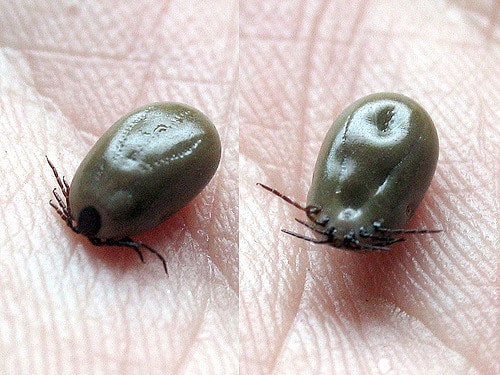
Engorged ticks after removal. If done properly, the tick should still be alive after you remove it.
Types of Tick Removal Tools
Tick removal tools can be broken down into five types: tweezers, V-shaped tools, tick keys, twist tools, and tick lassos. Some are much more effective than others. Here’s what you need to know.
Tweezer Tools
Tweezers are what experts recommend for removing ticks. However, not all tweezers work well for removing ticks. Tweezers which are designed for plucking eyebrows usually have wide, straight ends. These make it hard to grasp the tick at its head, especially when the tick is embedded deep into soft skin. It is also nearly impossible to properly remove nymph ticks with normal tweezers.
Instead, look for tweezers which have pointy ends (such as tweezers for ingrown hairs or “precision tweezers”). These will be able to grasp and remove adult ticks as well as tiny nymph ticks.
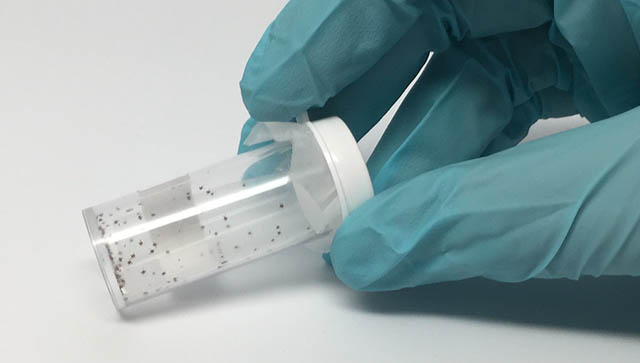
Larval and nymph ticks are so small that the only way to remove them safely is with finely-pointed tweezers. Other types of tick tools don’t work on these ticks unless they are fully engorged. By that point, they might have already transferred Lyme.
V-Shaped Tools
V-shaped tick tools are very easy to use and do a good job of grasping ticks at their mouthparts. They are especially useful for removing ticks from little kids who won’t sit still. Just make sure you are pulling upwards and not off to the side. However, V-shaped tools don’t work well on nymph ticks. Those ticks are too small for the tool to grasp the tick well.
Tick Keys
Tick keys are essentially V-tools which have been put on a keychain. This makes it very convenient to carry the tool with you at all times.
Twist Tools (Not Recommended)
You might have read that you can grab a tick’s body and “unscrew it.” The idea is that the twisting motion will cause the tick’s jaws to unlatch. Many popular tick removal tools (such as the O’Tom Tick Twister) are based on this idea. However, tick’s mouths are not screw-shaped. You cannot unscrew them. Rather, ticks have barbs on their mouthparts which allow them to get a damn-good grip on your skin.
As warned about here, “Twisting off the head should be avoided, because this may cause the tick’s potentially infectious body fluids to escape.” Further, studies show that twisting increases the likelihood that the mouth parts will break off in the skin.
The CDC says that you should always remove a tick by pulling straight upwards in a clean motion. So avoid using any tick removal tools which work by twisting.
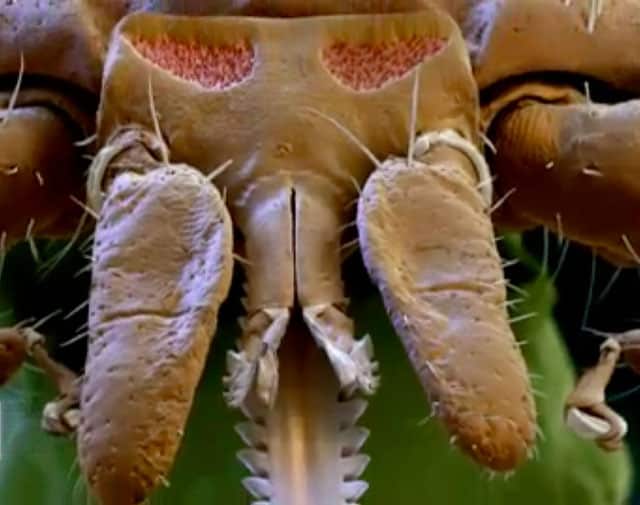
Ticks don’t have screw-shaped mouths, so you can’t “unscrew” them.
Tick Lassos (Not Recommended)
These tools have a little string “lasso” which you put around the tick. Then you pull the lasso around the tick mouth parts and pull. These tools make it easy to remove ticks in difficult places, such as on top of the head. They also make it easy to remove ticks from squirmy children.
The problem is that tick lasso tools don’t pull straight upwards, so there is an increased chance of the tick head remaining in the skin. Lasso tools also don’t seem to work as well on tiny nymph ticks or ticks which aren’t engorged yet.
The Best Tick Removal Tools
Here are some of the best tick removal tools that are actually safe for human use. Remember, a tick removal tool only works if you have it with you. For that reason, my #1 pick is Tick Patrol because it can be carried on your keychain or in your wallet. However, it won’t remove nymph ticks so I also keep a pair of needle-nose tweezers (#2 or #3) in my hiking first aid kit. These tweezers aren’t practical for everyday carry but do a much better job of removing tiny ticks safely.
1.
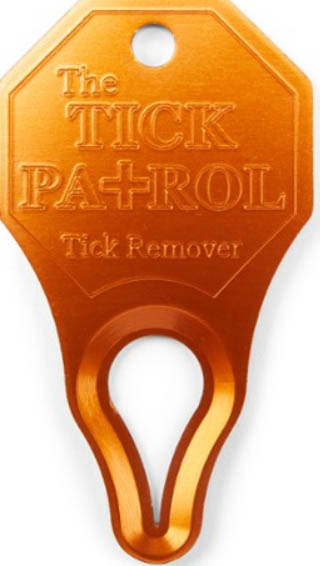
The reason I like this tick removal tool is because it can be attached to your keychain, which means you are more likely to actually have it on you when you notice a tick bite. It’s wide design makes it easy to hold. The shape is suitable for ticks on humans or pets.
- Pros: Can carry it on your keychain; easy to use; works on humans and animals
- Cons: Doesn’t remove nymph ticks well
- or here at Amazon
2. Majestic Tweezers
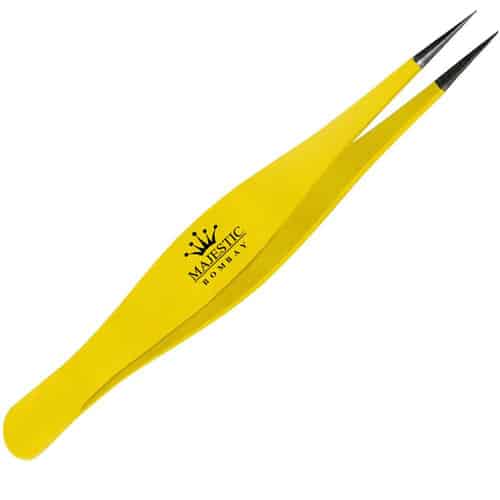
These tweezers are wha I keep in my hiking first aid kit. Even though they are marketed for removing ingrown hairs, they are perfect for removing ticks as well as splinters. The pointy end makes it very easy to grasp ticks near their mouthparts. You can even grasp nymph ticks without a problem.
The only real downside with using these tweezers for tick removal is that they are SHARP. They do come with a cap and a little tube that you can use for storage. Make sure you don’t lose the cap or the tweezers will poke a hole in your first aid kit.
- Pros: Removes nymph ticks as well as adults; also great for removing splinters
- Cons: Large; easy to lose cap; can’t carry on keychain
- Buy Here
3. TickEase
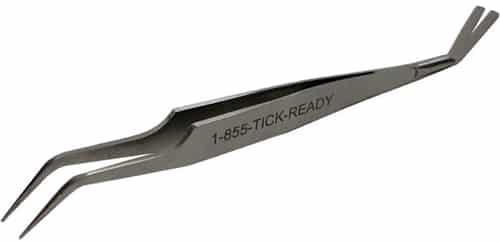
This tick removal tool is double sided. One side has very fine, pointy tips for grasping ticks at the head. You can even get nymph ticks with them. The other side of the tool has the V-shaped scoop for removing adult or engorged ticks easier. This makes it the perfect tool if you have pets or squirmy kids. The tool comes with a cap but, like with most pointy tweezers, they are hard to carry with you on the go.
- Pros: Can use on adult or nymph ticks; V tool makes removal easier
- Cons: Large, easy to lose cap; can’t carry on keychain
- Buy Here
4. TickCheck Tool
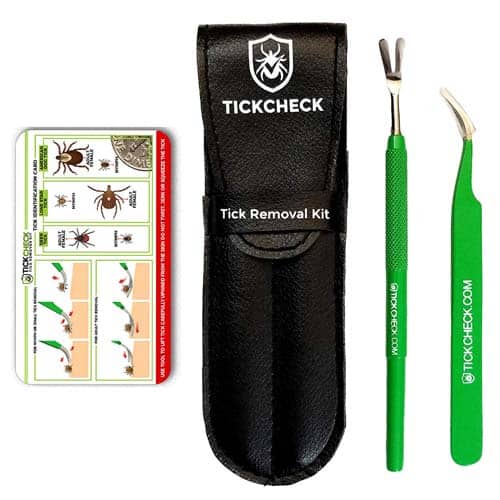
This is a set of two tick removal tools: one fine-point tweezer and a V-shaped tool. They come in a handy carrying case and also comes with a tick identification card. The handles on the tools are wider, so it does make it slightly easier to hold the tool.
- Pros: Two tools in set; carrying case, thick handles for good grip
- Cons: Bulky to carry around with you
- Buy Here
5. Tick Nipper
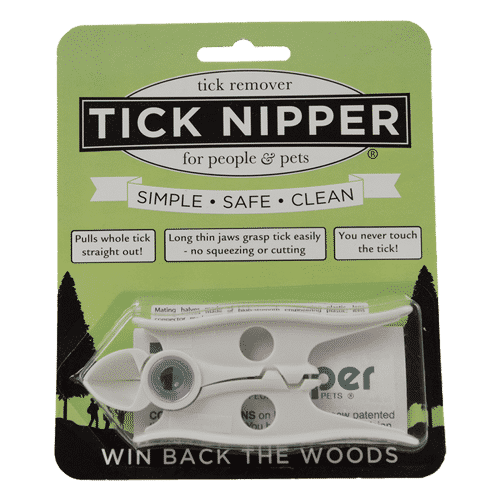
This tick removal tool has a slot that you use to grab the tick. Just pull upwards to remove the tick, head and all. The scoop will catch the tick, so you don’t risk dropping it.
The good thing about this tool is that it allows you to securely grasp the tick at the right spot without risk of cutting off the head by mistake. It also has a built-in magnifying glass which you can use to look for ticks on your body or make sure you got all of the tick out.
- Pros: Good for people with unsteady hands; magnifying glass
- Cons: Doesn’t work very well on nymph ticks
- Buy Here
6. Uncle Bill’s Sliver Gripper
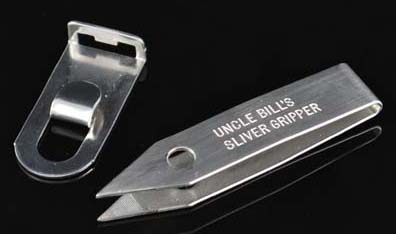
These tweezers are great because they have a nice pointy end for grasping ticks. The lid cover means they also are suitable for EDC (everyday carry). While I still find it easier to use the Majestic Tweezers above, these are way easier to carry with you.
- Pros: Good for adult and nymph ticks; has cap, can put on keychain
- Cons: Pointy end not very precise
- Buy Here
7. Mini Tweezer Set
Because I don’t always have my first aid kit with me, I got a pair of these miniature pointed-tip tweezers and keep them in my wallet (they come in a set; the flat-tipped ones aren’t suitable for removing ticks). This way I always have a pair of tweezers on me. They are cheap and admittedly kind of crappy, but the ends line up well enough and they get the job done. Revlon also makes mini tweezers that come with a carrying case)
- Pros: Only 2.5 inches long; fits in a wallet; good for adult and nymph ticks
- Cons: No cap; not as precise as some larger tweezers
- Buy Here
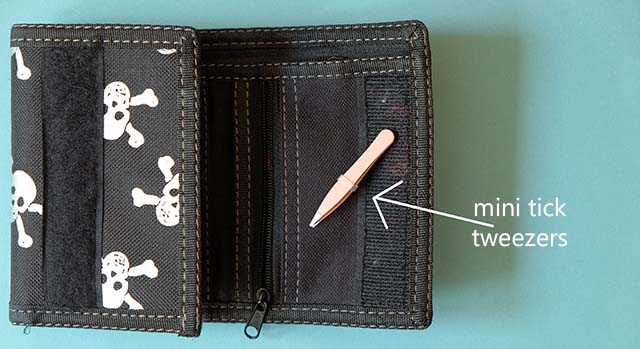
Here’s what the tweezers look like in my wallet. Yes, my wallet is dorky but it has lots of pockets 🙂
What If the Head Gets Stuck in the Skin?
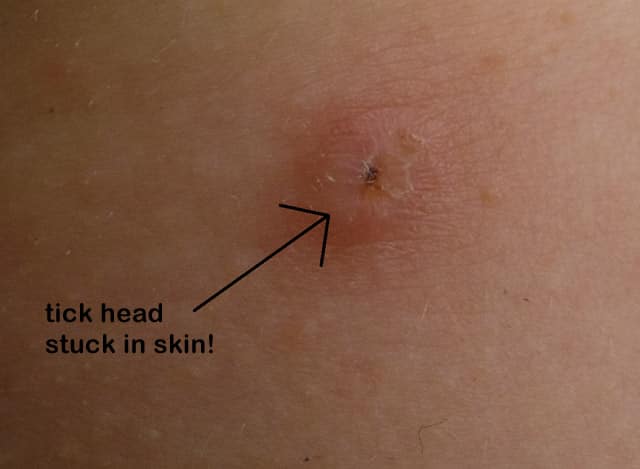
If you use the tick removal tool properly, the head should come out of the bite point. However, even when pulled out properly, the tick head can still break off and get stuck in your skin.
To remove a stuck tick head, you can try to dig it out like you would a splinter (you’ve got a safety pin in your camping first aid kit, right?) However, this is actually a lot harder than you’d think. The little barbs on the tick mouth parts get deeply embedded into the skin.
I recently had a tick head get stuck in my skin. It caused a surprising amount of inflammation around the bite site. The tick head eventually came out on its own, but it took two weeks.
Read about how to remove a stuck tick head here.
Keep a Watch for Lyme’s Disease
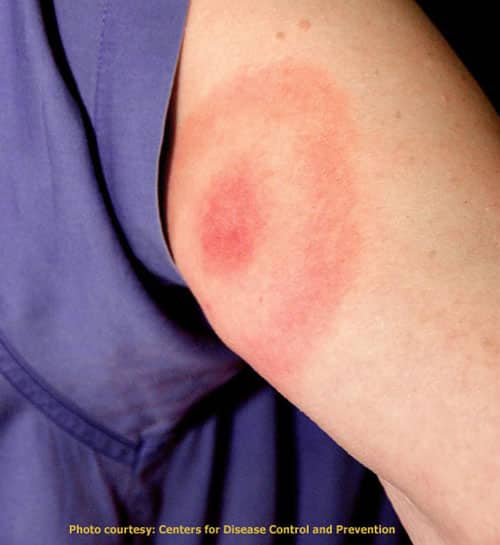
In 70-80% of cases of Lyme’s disease, people will develop a rash on the site of the tick bite. The rash usually occurs an average of 7 days after the bite, but can be as soon as 3 days or as late as 30 days.
Note that the rash isn’t always a bull’s eye shape. Be on the lookout for any rash, especially a rash which is spreading. When I got Lyme disease, it was not in a bull’s-eye shape. See pictures of Lyme disease rashes.
Preventing Lyme Disease After Being Bit
Unless you send each tick which bites you off for testing, you won’t know for sure whether you might have gotten Lyme disease. Basically you have to wait, watch for a rash (which not everyone gets), and hope you don’t get sick.
Also read: First Symptoms of Lyme Disease
What About Extractor Tools?
Extractor tools are designed to suck venom out of your skin. They are usually used for snake bites, scorpion bites, and bee stings, but many people use them after getting bit by a tick. There’s not much evidence they actually reduce the liklihood of of Lymes, but they definitely don’t hurt. This one is popular and cheap.
Resources:
https://www.lymeneteurope.org/info/tick-removal
https://www.thoughtco.com/wrong-ways-to-remove-a-tick-1968605
http://www.dailymail.co.uk/health/article-4515658/Video-woman-putting-oil-tick-dangerous.html#ixzz54pdCcrK7
https://www.lymeneteurope.org/info/tick-removal
https://www.cdc.gov/ticks/removing_a_tick.html
Image credits:
“Tick | Zecke | Flått” (CC BY 2.0) by Pw95,
“Bullseye” (CC BY-ND 2.0) by fairfaxcounty,
“Eat Me !” (CC BY-ND 2.0) by DrPhotoMoto,
“Ticks on Finger” (CC BY-ND 2.0) by fairfaxcounty,
“Deer Tick (Ixodes scapularis) ♀” (CC BY-NC-ND 2.0) by Goshzilla – Dann,
“Deer Tick Bite 3” (CC BY-NC-ND 2.0) by chrismek
“Juvenile Deer Ticks” (CC BY 2.0) by NIAID


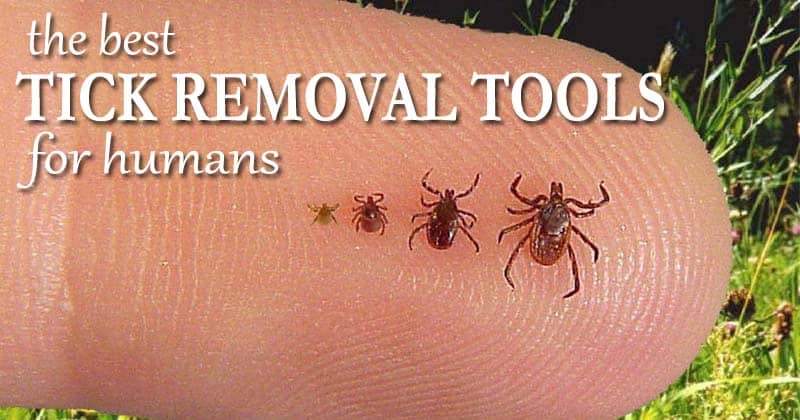
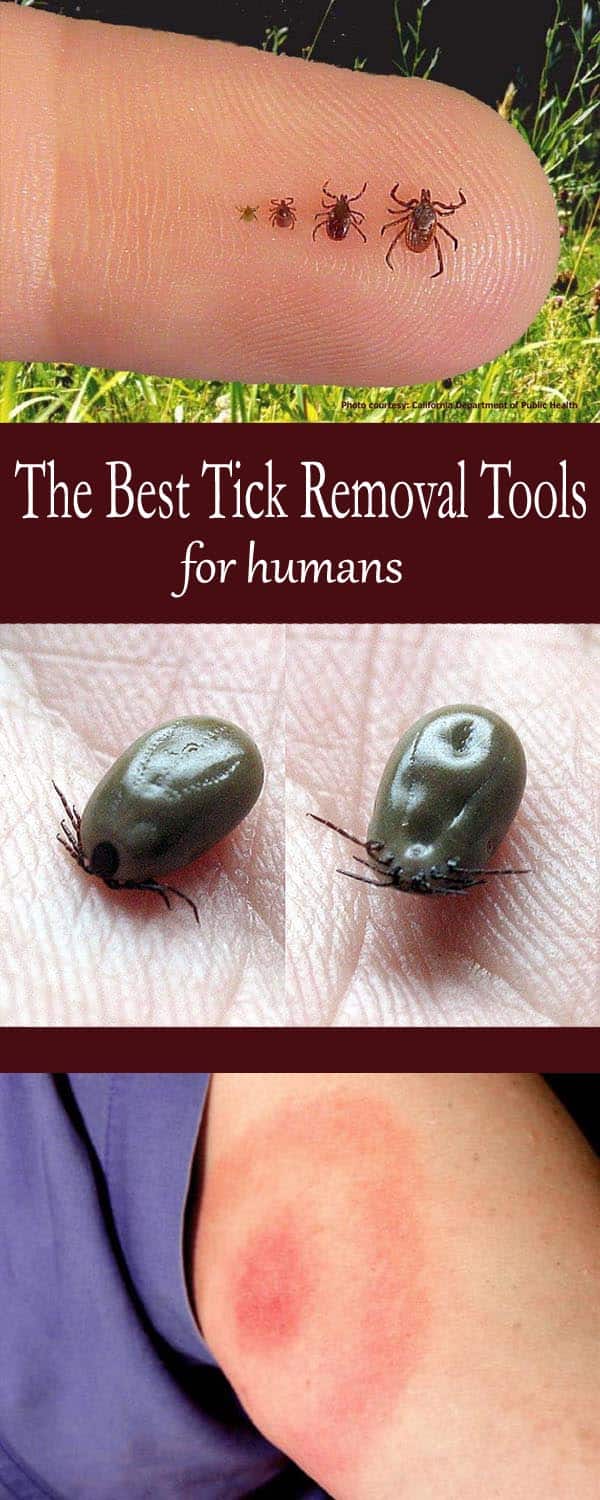

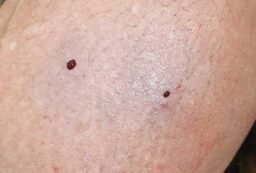








13 Comments
Janet Thieman
June 1, 2019 at 5:40 amI realize that this article says to never twist a tick and especially don’t use the ‘Tick Twister’ tool. The past couple of years our cats have had several ticks get embedded in them. Usually, when we find the ticks on the cats they are engorged with blood. We discovered the ‘Tick Twister’ tool on Amazon.com and we thought that we would give it a try. We started using it and it was amazing. It worked very well and every time we used it it would completely remove the complete tick alive with none of their body parts left in our kitties. I really thought that should put my two cents in about how well it works.
Janet Thieman
[email protected]
(website – na)
Diane
June 3, 2019 at 12:32 pmThank for the comment. I’ve got to stick with the CDC recommendation of never twisting a tick though as the mouth parts might come out.
Name *
July 13, 2019 at 10:38 pmDiane, you are providing misleading information by telling people not to use twisting methods to remove ticks. The no twisting advice applies to the use of tweezers. THE NO TWISTING ADVICE DOES NOT APPLY TO OTHER METHODS.
When using FINE TIPPED TWEEZERS, The CDC instructs, “Pull upward with steady, even pressure. Don’t twist or jerk the tick pulling straight without twisting.”
The Tick Twister, Tick Tornado, Tick Trix, and other new tools work extremely well by twisting the tick to flatten its barbs and more easily remove the tick.
These newer methods, which twist the tick to flatten the barbs and more easily remove it, are preferred by many experts in the field.
Diane
July 14, 2019 at 12:38 pmIt’s not just the CDC who says to never twist a tick: https://www.lymediseaseaction.org.uk/about-ticks/tick-removal/, https://www.hopkinslyme.org/lyme-disease/lyme-disease-lifestyle-options-and-prevention-measures-to-enhance-health/, https://www.healthlinkbc.ca/health-topics/tp23585spec, https://extension.umaine.edu/ticks/removal/, https://www.fareham.gov.uk/licensing_and_inspections/pest_control/tickslyme.aspx, https://www.health.ny.gov/publications/2813/, and many other GOV websites say to never twist. There is this study which analyzed various tick removal tools. It did find that twisting makes it easier to remove the tick (though didn’t say anything about whether heads stayed in more frequently) but still found that pulling upwards with a V tool worked best. (https://www.ncbi.nlm.nih.gov/pubmed/22733005)
“Twisting of the female I. ricinus ticks reduced the force required for extraction, the adverse reaction of the animal and the time needed for removal. The device with a “V”-shaped slot which allows a grabbing of the mouthparts delivered the best results according to the condition of the mouthparts and the intactness of the female I. ricinus tick’s body. Therefore, grabbing the mouthparts and twisting can be recommended for removal of I. ricinus females from pets.
Name *
September 16, 2019 at 7:35 pmFYI from Peersman study, CDC published in WSJ – “In a 2002 study at the Centers for Disease Control and Prevention, published in the Journal of Medical Entomology, the Pro-Tick Remedy and the Tick Nipper both effectively removed five nymphal-stage deer ticks placed on laboratory rabbits. In another study, published in Wilderness & Environmental Medicine in 1998, both devices were more effective at removing mouth parts than regular-size household tweezers, says study co-author Glen R. Needham, an emeritus associate professor of entomology at Ohio State University in Columbus.”
Dick Gadd
October 9, 2019 at 8:06 pmJust an observation – the two adult engorged deer ticks in the hand picture are absent their mouthparts. BTW Nice website
Diane
October 11, 2019 at 1:56 pmYes – great observation. It’s actually not my photo. I haven’t had the displeasure of gathering that many ticks at once since I was a kid; I walked through a tick swarm while hiking with my family when I was 11. No one else had ticks on them but we removed at least 30 from me. It was gross. I felt phantom crawling sensations all over me for days afterwards. And thanks! 😀
Thomas
May 23, 2021 at 3:23 amLight a kitchen match, wait a few seconds and blow it out. Now touch the tick with the hot matchhead and pick it up.
Diane
May 24, 2021 at 8:08 amThat will get a tick out but it’s actually a very bad idea. Anything that irritates a tick increases the chances that the tick will regurgitate its stomach content into the wound, thus increasing the likelihood of disease transmission. The same goes for other methods like putting essentil oil or Vaseline over a tick. I’ve pulled out so many ticks in the past couple years that I now keep mini tweezers on me at all times in my wallet. But I’m also a “prepper” and take my EDC seriously 🙂
Eddie Roberts
June 7, 2023 at 12:49 amBefore removing any tick completely wet the entire tick and skin around it with full strength concentrated Lysol just once. This will immobilize the tick and kill all bacteria in or around the site of the bite. Then remove the tick. Nothing else needs to be done and there is a 99% chance you will never have any infection.
Diane
June 11, 2023 at 8:42 pmThat actually sounds like terrible advice: anything which irritates the tick can cause it to regurgitate its stomach contents into your skin — thus increasing the chances of disease transmission. Pointy tweezers is what the CDC recommends and what works for me!
Nancy Timko
July 2, 2023 at 12:41 amHusband has been to the Med Express twice this week for ticks. Doctor used pointed tweezers and said to twist the tick counterclockwise. He had to go as we could not find our Tick Twister and I didn’t have time to purchase another one. I will now just get a good pointed head tweezer.
Diane
July 3, 2023 at 2:26 pmThat “counterclockwise” myth is really prevalent. A lot of doctors heard that a long time ago and haven’t updated their knowledge of tick removal since then. There is absolutely no reason that twisting a tick would help remove it (it’s just going to increase the chances of the head breaking off and getting stuck in the skin!).
The CDC says that here: https://www.cdc.gov/ticks/removing_a_tick.html#:~:text=Pull%20upward%20with%20steady%2C%20even,and%20let%20the%20skin%20heal.
The US Army says the same here: https://www.army.mil/article/166962/health_experts_offer_tips_for_defending_against_ticks
Apparently there are some exceptions though, like this report of a tick stuck to the eye and wouldn’t release when pulled straight up so the doctors used the counterclockwise method: https://www.ncbi.nlm.nih.gov/pmc/articles/PMC9808137/